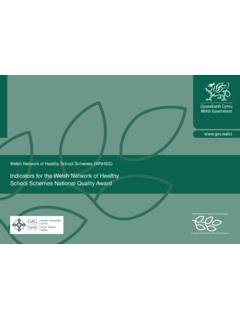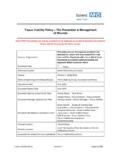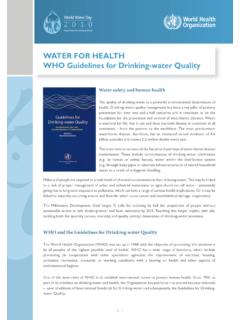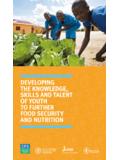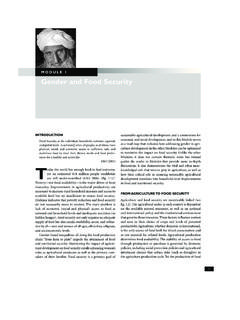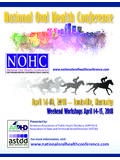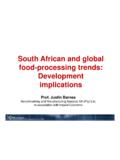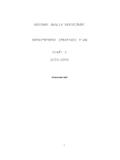Transcription of Definitions of indicators for child anthropometry - WHO
1 Interpretation GuideNutrition Landscape Information System (NLIS) Country Profile indicators nutrition Landscape Information System (NLIS) COUNTRY PROFILE indicators Interpretation Guide WHO Library Cataloguing-in-Publication Data: nutrition Landscape Information System (NLIS) country profile indicators : interpretation guide. status. disorders. nutrition disorders. collection. status indicators . Health Organization. ISBN 978 92 4 159995 5 (NLM classification: QU 145) World Health Organization 2010 All rights reserved. Publications of the World Health Organization can be obtained from WHO Press, World Health Organization, 20 Avenue Appia, 1211 Geneva 27, Switzerland (tel.)
2 : +41 22 791 3264; fax: +41 22 791 4857; e-mail: Requests for permission to reproduce or translate WHO publications whether for sale or for noncommercial distribution should be addressed to WHO Press, at the above address (fax: +41 22 791 4806; e-mail: The designations employed and the presentation of the material in this publication do not imply the expression of any opinion whatsoever on the part of the World Health Organization concerning the legal status of any country, territory, city or area or of its authorities, or concerning the delimitation of its frontiers or boundaries.)
3 Dotted lines on maps represent approximate border lines for which there may not yet be full agreement. The mention of specific companies or of certain manufacturers products does not imply that they are endorsed or recommended by the World Health Organization in preference to others of a similar nature that are not mentioned. Errors and omissions excepted, the names of proprietary products are distinguished by initial capital letters. All reasonable precautions have been taken by the World Health Organization to verify the information contained in this publication. However, the published material is being distributed without warranty of any kind, either expressed or implied.
4 The responsibility for the interpretation and use of the material lies with the reader. In no event shall the World Health Organization be liable for damages arising from its use. Printed by the WHO Document Production Services, Geneva, Switzerland Acknowledgement The development of the nutrition Landscape Information System (NLIS) was one of the three parallel activities of the Landscape Analysis project; the second being the development of country typologies for "readiness" to accelerate action through the desk review; and the third, the implementation of in-depth country assessments.
5 The development of the NLIS aimed at raising awareness of, and concern about, the Country Profiles among country policy-makers and other stakeholders including donors. Bringing various existing nutrition -related databases together inside WHO and also those of other partner agencies to develop NLIS should help nutrition action as a whole to be presented in a more comprehensive way. This is a living document which may be updated based on new research or feedback from users. Special acknowledgement is made to the Bill & Melinda Gates Foundation for supporting the implementation of the Landscape Analysis on Countries' Readiness to Accelerate Action in nutrition .
6 Deep appreciations are expressed first of all to the Governments and the intersectoral/interagency country teams in respective countries who have undertaken the Landscape Analysis country assessments and also those who have shown the great interest in undertaking these country assessments, and also to the members of the Partner Agency Group, including UN agencies (in particular FAO, UNICEF, WFP, World Bank), bilateral agencies, NGOs (in particular Helen Keller International and GAIN), research and academic institutions such as Medical Research Council in South Africa as well as a number of collaborating experts who had supported and guided in various stages of the preparations and implementation of the Landscape Analysis.
7 CONTENTS: Preface Malnutrition in children ..1 Underweight, stunting, wasting and overweight .. 1 Low birth 2 Malnutrition in women ..3 Moderate and severe thinness, underweight, overweight, obesity .. 3 Vitamin and mineral 4 Vitamin A deficiency .. 6 Iodine deficiency .. 7 Health services ..8 Births attended by skilled health personnel ..8 Children aged 6 59 months receiving vitamin A supplements .. 9 Children aged 1 year immunized against 10 Children with diarrhoea who receiving zinc .. 10 Improved sanitation facilities and drinking-water sources .. 11 Women receiving iron and folate supplements during pregnancy.
8 12 Food security ..13 Population living on less than US$ 1 per 13 Population with less than the minimum dietary energy 14 Households consuming adequately iodized salt ( 15 parts per million) .. 15 Caring Infant and young child 16 Children with diarrhoea receiving oral rehydration therapy and continued feeding .. 19 Women aged 15 19 years who are mothers or are pregnant with their first child .. 19 Health expenditure .. 20 nutrition component of the United Nations Development Assistance 20 nutrition component of poverty reduction strategy 23 nutrition governance.
9 24 Monitoring and enforcing the International Code on Marketing of Breast-milk Substitutes .. 25 Maternity leave .. 26 Degree training in nutrition and nutrition in medical curricula .. 27 Density of nutrition 27 Density of nurses and midwives .. 27 Gross domestic product per capita and annual growth 28 Official development assistance .. 29 Low-income food-deficit countries (LIFDC) .. 29 Meta- indicators ..30 Women in national parliaments .. 30 Averaged aggregate governance 31 Gender equality .. 33 Global Hunger 35 Human development 36 Retention and school drop-out.
10 37 Under-five mortality .. 37 Female education levels .. 38 Preface The nutrition Landscape Information System (NLIS) was developed as part of the Landscape Analysis on Readiness to Accelerate Action in nutrition . While many individual sources of publicly-available data exist, it can be a challenge to identify, collect and organize those data systematically from various sources as well as to monitor any updates as new data become available. Therefore, the main aims of NLIS are to: Bring together nutrition -related indicators in standardized form. NLIS ensures access to a variety of nutrition indicators as well as health, food, care, development and economic indicators related to nutrition in a single easy-to-access and user-friendly location.










